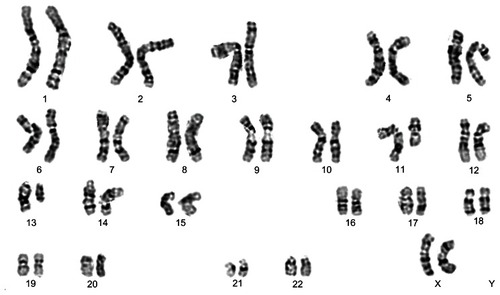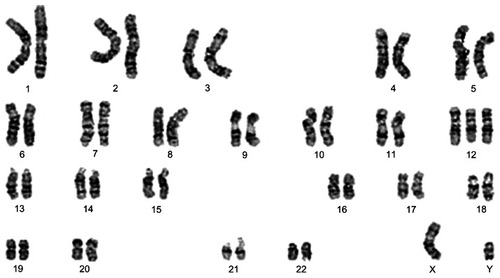Video abstract
Point your SmartPhone at the code above. If you have a QR code reader the video abstract will appear. Or use:
Chronic lymphocytic leukemia is the most common leukemia in adults. By cytogenetic investigations major subgroups of the disease can be identified that reflect different routes of tumor development. Of these chromosomal deviations, trisomy 12 and deletions of parts of either the long arm of chromosome 13, the long arm of chromosome 11, or the short arm of chromosome 17 are most commonly detected. In some of these aberrations the molecular target has been identified as eg, ataxia telangiectasia mutated (ATM) in case of deletions of chromosomal region 11q22~23 and the genes encoding microRNAs miR-15a/16-1 as likely targets of deletions of chromosomal band 13q14.3. Of note, these aberrations do not characterize independent subgroups but often coexist within the metaphases of one tumor. Generally, complex aberrations are associated with a worse prognosis than simple karyotypic alterations. Due to smaller sizes of the missing segment the detection of recurrent deletions is not always possible by means of classical cytogenetics but requires more advanced techniques as in particular fluorescence in situ hybridization (FISH). Nevertheless, at this time it is not recommended to replace classical cytogenetics by FISH because this would miss additional information given by complex or secondary karyotypic alterations. However, the results of cytogenetic analyses allow the stratification of prognostic and predictive groups of the disease. Of these, the group characterized by deletions involving TP53 is clinically most relevant. In the future refined methods as eg, array-based comparative genomic hybridization will supplement the existing techniques to characterize CLL.
Chronic lymphocytic leukemia: the most common leukemia in Western countries
Chronic lymphocytic leukemia (CLL) is characterized by the presence of small, monomorphic, round to slightly irregular B lymphocytes in the peripheral blood, bone marrow, lymph nodes, liver, and spleen. Nonleukemic disease presenting with the tissue morphology and immunophenotype of CLL are termed small lymphocytic lymphoma (SLL).Citation1 The disease is more common in males. Patients are often asymptomatic at the time of diagnosis but the continuing accumulation of CLL lymphocytes leads to development of symptoms, disease-related complications, and a need for therapy. CLL causes approximately 4,500 deaths per year in the United States alone.Citation2,Citation3
There are approximately 15,000 new cases of CLL reported annually in the United StatesCitation3 and CLL is generally the most common leukemia of the adult population in Western countries with an incidence of two to six cases per 100,000 persons/year. Incidence appears to be correlated with age, with more than ten cases per 100,000 in those aged over 65 years. Moreover, approximately 6% of elderly individuals present with a clonal B-cell population that immunophenotypically and cytogenetically resembles CLL.Citation4 This latter condition is called monoclonal B-cell lymphocytosis (MBL). MBL is known to progress to CLL in approximately 2% of cases, and CLL may generally be preceded by MBL. Thus, MBL may sometimes be more appropriately considered to be early or low stage CLL, and in the past patients have been diagnosed as having CLL when they would only fulfill the diagnostic criteria for MBL. There is not only a progression from MBL to CLL, but CLL is also able to undergo further clinicopathologic transformation to become an aggressive lymphoma with a predominance of diffuse large B-cell lymphomas. This transformation is referred to as Richter syndrome.
Although the f irst description of CLL dates back 150 years there is still little known about the etiology of the disease. Pathogenetically, the immunophenotype of the resting B cells characterizing CLL (CD5, CD23, CD27, and low level of surface immunoglobulin [Ig]) is different from that of normal B cells. CLL cells either have somatically mutated or unmutated IgV genes, suggesting that the corresponding tumor precursor cells originated from an antigen-dependent or -independent developmental stage, respectively.Citation4
Cytogenetic findings: methods, and pathogenetic and clinical implications
Generally, there is little doubt that CLL is a monoclonal disease which makes it similar to most other benign or malignant tumors. This is supported by the results of cytogenetic studies. Techniques that appear to be for specific in vitro stimulation of the tumor cells in CLL by an immunostimulatory CpG oligonucleotide plus interleukin 2Citation5 represent a major step forward in understanding the pathogenesis of the disease. By applying these techniques, metaphases can be obtained in the vast majority of cases. Clonal chromosome abnormalities have been detected in more than 80% of the cases studied through the use of classical cytogenetics.Citation6 The percentage of cases with at least one abnormalitiy increases when fluorescence in situ hybridization (FISH) is applied using appropriate probes to detect the most frequent abnormalities in addition to classical cytogenetics, mainly due to the detection of deletions under the detection limit made possible through the analysis of chromosomal bands.Citation3 There is no doubt that most cytogenetic changes seen in CLL are causally related to the disease and its progression, and cytogenetic analyses in CLL have generally turned out to be good for providing prognoses and predictions. Analyses are usually carried out by classical as well as molecular cytogenetic methods. There has been debate as to whether FISH can replace classical cytogenetics in the genetic analysis of CLL, but the larger spectrum of aberrations that can be detected through classical cytogenetics seems to make this indispensable at present.Citation6
In contrast to most other leukemias and lymphomas, typical recurrent chromosomal translocations are very rare in CLL, if they exist at all. Translocations involving chromosomal band 14q32 including the t(11;14)(q13;q32) () typically seen in Mantle cell lymphoma (MCL) have repeatedly have been reported, but distinguishing MCL from CLL can be complicated due to overlapping morphologic features and similar clinical manifestations.Citation7 Hence, it may be speculated that these cases would be diagnosed as MCL if strict diagnostic criteria were followed.
Figure 1 The translocation t(11;14)(q13;q32) is a nonrandom chromosomal rearrangement in Mantle cell lymphoma.
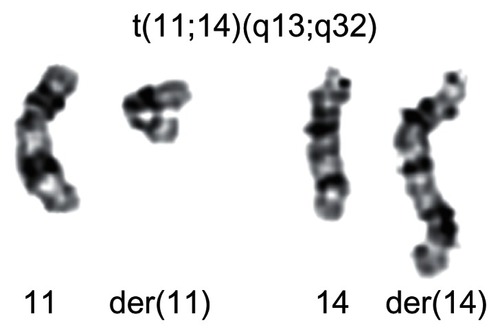
However, the identification of four main cytogenetic changes of in CLL was possible due to several recurrent and common gains and losses of chromosomal material: these are trisomy 12 (16%), and deletions of chromosomal regions 13q14 (55%), 11q (18%), and 17p (7%).Citation4 Chromosomal deviations can occur either as the sole chromosome abnormality or coexist with other changes of the number or structure of the chromosomes, which leads to more complex changes of the karyotype. This also holds true for the most frequent cytogenetic abnormalities, which allows the independent subgroups to be distinguished. It is noted that these abnormalities are not mutually exclusive and so can occur together ().
Deletions of the long arm of chromosome 13 involving 13q14: microRNAs impairing apoptosis?
The most frequent chromosomal abnormalities observed in CLL are deletions of the long arm of chromosome 13 involving 13q14, which occurs in more than half of all CLL cases.Citation8–Citation10 The size of the deletion varies from those comprising almost the entire long arm of the chromosome to those detectable only by FISH (). Most of these deletions are monoallelic, but some are biallelic. In a study by Hernández et al,Citation11 roughly 20% of the deletions that were detected as the sole abnormality at the time of first diagnosis were found to be biallelic. This deletion is found at the same frequency in MBL.Citation12 The 13q14 deletion is not confined to CLL, as deletions of the same minimal deleted region (MDR) appear to also occur in subsets of multiple myelomas and mature T-cell lymphomas. Moreover, deletions comprising band 13q14 have been found in several benign and malignant solid tumors as lipomas and thyroid adenomas.Citation13–Citation18 In CLL the minimal deleted region contains sequences encoding two apparently sterile transcripts: DLEU2 (deleted in leukemia-2) and DLEU1.Citation19,Citation20 Intron 4 of DLEU2 encodes two microRNAs, miR-15a and miR-16-1, which are processed from its primary transcripts, and so share DLEU2’s transcriptional regulation and seem to interact with pathways governing apoptosis.Citation21 Downregulation of DLEU2 and miR-15a/16-1 expression compared to normal B cells has been described for CLL without 13q14 deletions as well,Citation22 suggesting an epigenetic mechanism is suppressing the DLEU2/miR-15a/16-1 cluster in cases lacking 13q14 deletion.Citation23 miRNAs miR-15a/16-1 may have a pathogenetic function, and both seem to be involved in keeping the balance between proliferation and apoptosis. Nevertheless, their action as a posttranscriptional repressor of the BCL2 (B-cell lymphoma 2) expression is still a matter of an debate.Citation24–Citation26
Figure 3 Deletions of chromosome 13 are the most frequent karyotype alterations in CLL. (A, left to right): Ideogram of chromosome 13, example of an interstitial deletion of the long arm of chromosome 13 in CLL, and example of a terminal deletion of chromosome 13 in CLL. (B) Part of a metaphase with monoallelic deletion of chromosome 13 as detected by FISH, the orange (spectrum: orange)-labeled probe detects the minimal deleted region, the green (spectrum: green)-labeled probe detects a terminal DNA segment of the long arm of chromosome 13 to facilitate its identification. Chromosomes are counterstained by DAPI. (C) Part of a metaphase with diallelic deletion of chromosome 13 as detected by FISH. For probes and counterstaining see (B). (D, left to right): nucleus of a normal cell without 13q-deletion and nucleus of a cell with biallelic deletion. For probes and counterstaining see (B).
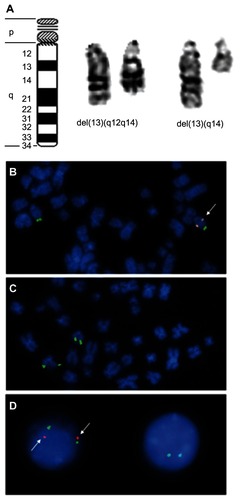
Deletions of chromosome 13 are associated with quite a favorable prognosis with no detectable impact if these occur as the sole genetic abnormality and if they are mono- or biallelic.Citation11,Citation27 It is interesting to note that the absence of del(13) (q14) seems to protect against the transformation of CLL into diffuse large B-cell lymphoma, as the absence of del(13)(q14) characterizes patient subgroups at high risk of developing Richter syndrome.Citation28 Some recent reports suggest that the size of the deletions influences prognosis. In particular, codeletion of the retinoblastoma gene (RB1) locus seems to be relevant.Citation29
Trisomy 12: gene dosage effects and several oncogenes
Deletions of chromosome 13 trisomy 12 () appear to be similar to frequent karyotypic alterations in CLL that are not confined to this type of tumor, such as a cytogenetic subgroup of uterine leiomyomas characterized by trisomy 12 as the sole karyotypic abnormality.Citation30 The molecular mechanisms by which trisomy 12 supports tumorigenic transformation in CLL are unknown. However, it is assumed that trisomy 12 may cause an elevated gene dosage of a candidate proto-oncogene. Several genes with oncogenic potential have been assigned to chromosome 12, such as HMGA2 (high-mobility group AT-hook 2)Citation31 which encodes a so-called architectural transcription factor implicated in mechanisms of benign and malignant tumorigenesis. Further examples are MDM2 (murine double minute 2), which is known to be amplified in some malignant solid tumors encoding a major repressor of p53, and GLI1 (glioma-associated oncogene homologue 1). Overall, the prognosis of CLL with trisomy as the only aberration is less favorable than that of CLL with deletions of the long arm of chromosome 13, but better than that of cases with either deletions of chromosome 11 or 17.
Deletions of the long arm of chromosome 11 involving 11q22-q23: ATM deficiency destabilizing the tumor genome
Deletions of chromosomal region 11q22-q23 () can be detected in almost 20% of cases, which makes them the second most frequent karyotypic change in CLL. These deletions often lead to a hemizygous loss of the ataxia telangiectasia (ATM) gene.Citation32 Mechanistically, ATM is able to signal DNA damage and to mediate p53 activation which, as a major player assuring genome stability, can ultimately trigger apoptosis or oncogene-induced senescence if the damage is not repaired. Therefore, damaged cells are not adequately removed and ATM deficiency causes genomic instability.
Figure 5 Partial karyotypes showing recurrent chromosomal deletions in CLL. (A) Chromosomal pair 11 from a CLL showing a del(11)(q22). (B) Chromosomal pair 17 from a CLL showing a del(17)(p12). (C) Chromosomal pair 6 from a CLL showing a del(6)(q13q22).
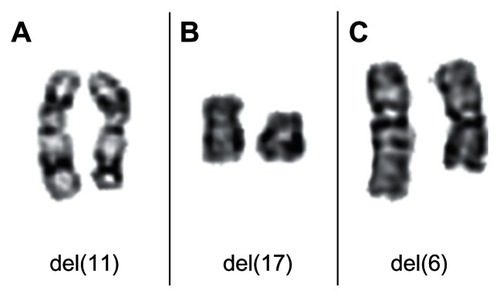
Deletions of the short arm of chromosome 17 involving 17p13: another p53 story
It appears that the same pathways are disturbed in CLL with deletions of chromosomal band 17p13 (), which is seen in about 5% of cases. These deletions always cause a loss of the TP53 tumor suppressor gene. Interestingly, in the majority of cases with cytogenetically visible monoallelic deletion, mutations have been detected in the remaining TP53 allele as well.Citation32 In rare cases, biallelic mutations of TP53 have been found without 17p deletions, leading to clinical, pathological, and prognostic features identical to 17p deletions. However, these genetic aberrations carry the same devastating prognostic and predictive impact as 17p deletions.Citation33 Additional techniques such as sequencing are now being applied to analyze mutations affecting TP53 that escape detection by classical cytogenetics.
Rare, but recurrent cytogenetic abnormalities in CLL
Other recurrent but rare karyotypic abnormalities in CLL are deletion of the long arm of chromosome 6 (), translocations involving 14q32 chromosome 3, and trisomies of the long arm of chromosome 8.Citation34–Citation40 The uncovering of complex karyotype aberrations in CLL is sometimes impossible without the application of molecular cytogenetic methods (). Complex aberrant karyotypes (defined as the existence of three or more clonal abnormalities identified by chromosomal band analysis changes) have generally been described to characterize an adverse prognostic group of CLL.Citation41 Only a few cases of Richter’s cytogenetic transformation of CLL have been studied in detail.Citation42
Figure 6 Complex aberrant karyotypes in CLL are associated with an adverse prognosis. Example of a CLL with a complex karyotypic rearrangement involving chromosomes 3, 4, 13, 14, 15, and 16. Karyotype: 47,XY,der(3)t(3;15)(q21;q22),t(4;16)(q31;q24),+12,del(13)(q14),der(14)t(3;14)(q21;q24),der(15)t(13;15)(q14;q22). (A) Representative G-banded karyotype. (B) SKY-FISH analysis.
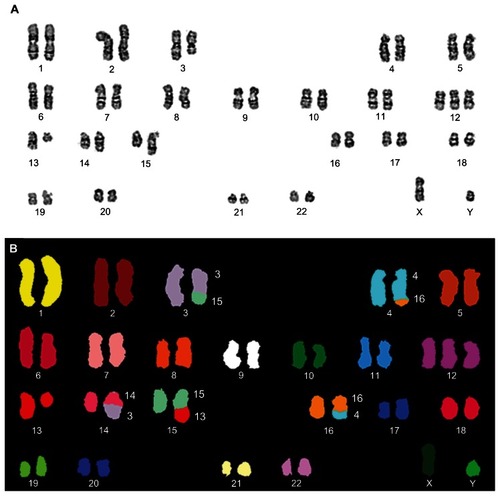
Prognostic and predictive implications of chromosomal abnormalities and miRNA deregulation in CLL
Numerous studies have provided clear evidence that chromosomal alterations in CLL have an impact on the patient’s prognosis. Nevertheless, the significance of predictive markers may change with emerging new therapies, and it will not be easy to clearly distinguish between the prognostic and predictive significance of changes. Those alterations that are detectable at the level of classical cytogenetics (ie, the analyses of chromosomal bands, or by FISH with commonly used DNA probes) and deletions of the Tp53 locus are highly relevant indicators of poor prognosis.
Recent studies indicate that the impact of these deletions and equivalent mutations in TP53 not only has prognostic impacts but also affects the response to therapy. Standard CLL-therapy is currently based on the use of fludarabine, but this treatment is generally ineffective in patients showing impairment of p53.Citation43 However, not all restrictions of p53 functions are detectable through the application of these techniques, and thus sequencing and functional assays are also used to identify genetic subgroups of CLL. For example, in vitro exposure to etoposide plus nutlin-3a allows the detection and identification of ATM and TP53 mutations.Citation44 Deletions of the ATM locus that are usually detectable by means of classical cytogenetics are generally associated with a poor prognosis as well, but recent studies suggest that chemoimmunotherapy may overcome the prognostic impact of 11q deletion and point to 11q deletion as a potential predictive factor for increased benefit by fludarabine– cyclophosphamide–rituximab (FCR) treatment.Citation45,Citation46
Trisomy 12 as the sole cytogenetic deviation is associated with a intermediate prognostic impact (median survival = 114 months)Citation47 but recent studies suggest that CLL patients with trisomy 12 and NOTCH1 (Notch homolog 1) mutations have a prognostic course worse than that with trisomy 12 alone. NOTCH1 mutations contribute to a significantly worse survival in trisomy 12 CLL patients compared to that of trisomy 12 alone.Citation48
CLL with 13q deletion as the sole cytogenetic abnormality usually has a good prognosis. However, it has become obvious from recent data that both the percentage of deleted nuclei and presence of larger deletions involving the RB1 locus can help to further refine the prognosis of del 13q-only cases. In particular, CLL carrying <70% of 13q deleted nuclei with deletions not including the RB1 locus were characterized by particularly long time-to-treatment. On the other hand, 13q deletions seen in <70% of nuclei but involving the RB1 locus, or 13q deletion in ≥70% of nuclei with or without RB1 deletions, are apparently associated with a shorter time-to-treatment.Citation49
The expression of microRNAs is a rapidly emerging field in cancer diagnosis and monitoring. In CLL, the expression of miR-150, miR-223, and miR-29b/c correlates with mutated IgHV (immunoglobulin heavy variable) and a favorable clinical course. Similarly, low expression of miR-223 and miR-29c was found to correlate with unmutated IgHV, ZAP-70 (zeta-chain-associated protein kinase 70) expression, and disease progression.Citation47 However, while miRNA expression patterns present a possible diagnostic and predictive tool, more data will be required before they can be integrated into daily clinical diagnostic practice.
Future directions in genetic analyses of CLL
The type and frequency of aberrations among the tumor cell population are major characteristics of CLL, so genetic analyses offer valuable tools for a prognostic and predictive stratification of patient groups. Currently, a combination of classical G-band analysis and FISH seems to be the best method of collecting relevant data. Despite its much higher resolution, FISH on interphase nuclei using a panel of probes covering the most frequent genomic inbalances seen in CLL still cannot replace classical cytogenetics, which is superior in detecting complex karyotypic alterations that are of prognostic impact. As adjuncts, the application of molecular cytogenetic methods for the interpretation of complex karyotypes () has considerable significance for selected cases following classical cytogenetics and interphase FISH. Array-based comparative genomic hybridization will become another important tool for the analysis of selected cases of CLL.Citation50–Citation52 Perhaps even more important is the combination of genetic analysis with functional or gene expression studies. As an example of this type of study, Decker et al were able to demonstrate that smoothened-inhibitor responsiveness correlated with elevated GLI1 and PTCH1 (protein Patched homolog 1) transcript levels and the presence of trisomy 12, while no other karyotype correlated with responsiveness.Citation53
Disclosure
The authors report no conflicts of interest in this work.
References
- SwerdlowSHCampoEHarrisNLWHO Classification of Tumors of Haematopoietic and Lymphoid TissuesLyon, FranceIARC Press2008
- LanasaMCNovel insights into the biology of CLLHematology Am Soc Hematol Educ Program20102010707621239773
- CramerPHallekMPrognostic factors in chronic lymphocytic leukemia – what do we need to know?Nat Rev Clin Oncol20118384720956983
- KleinUDalla-FaveraRNew insights into the pathogenesis of chronic lymphocytic leukemiaSemin Cancer Biol20102037738321029776
- DickerFSchnittgerSHaferlachTKernWSchochCImmunostimulatory oligonucleotide-induced metaphase cytogenetics detect chromosomal aberrations in 80% of CLL patients: A study of 132 CLL cases with correlation to FISH, IgVH status, and CD38 expressionBlood20061083152316016840733
- HaferlachCDickerFSchnittgerSKernWHaferlachTComprehensive genetic characterization of CLL: a study on 506 cases analysed with chromosome banding analysis, interphase FISH, IgV(H) status and immunophenotypingLeukemia2007212442245117805327
- HoAKHillSPreobrazhenskySNMillerMEChenZBahlerDWSmall B-cell neoplasms with typical mantle cell lymphoma immuno-phenotypes often include chronic lymphocytic leukemiasAm J Clin Pathol2009131273219095562
- DöhnerHStilgenbauerSBennerAGenomic aberrations and survival in chronic lymphocytic leukemiaN Engl J Med20003431910191611136261
- DöhnerHStilgenbauerSDöhnerKBentzMLichterPChromosome aberrations in B-cell chronic lymphocytic leukemia: reassessment based on molecular cytogenetic analysisJ Mol Med (Berl)19997726628110023780
- KalachikovSMigliazzaACayanisECloning and gene mapping of the chromosome 13q14 region deleted in chronic lymphocytic leukemiaGenomics1997423693779205107
- HernándezJARodríguezAEGonzálezMA high number of losses in 13q14 chromosome band is associated with a worse outcome and biological differences in patients with B-cell chronic lymphoid leukemiaHaematologica20099436437119252174
- RawstronACBennettFLO’ConnorSJMonoclonal B-cell lymphocytosis and chronic lymphocytic leukemiaN Engl J Med200835957558318687638
- BelgeGRoqueLSoaresJCytogenetic investigations of 340 thyroid hyperplasias and adenomas revealing correlations between cytogenetic findings and histologyCancer Genet Cytogenet199810142489460499
- DahlénADebiec-RychterMPedeutourFClustering of deletions on chromosome 13 in benign and low-malignant lipomatous tumorsInt J Cancer200310361662312494468
- CigudosaJCRaoPHCalasanzMJCharacterization of nonrandom chromosomal gains and losses in multiple myeloma by comparative genomic hybridizationBlood199891300730109531613
- LiuYHermansonMGrandérD13q deletions in lymphoid malignanciesBlood199586191119157655020
- StilgenbauerSNickolenkoJWilhelmJExpressed sequences as candidates for a novel tumor suppressor gene at band 13q14 in B-cell chronic lymphocytic leukemia and mantle cell lymphomaOncogene199816189118979583687
- RosenwaldAOttGKrumdiekAKA biological role for deletions in chromosomal band 13q14 in mantle cell and peripheral t-cell lymphomas?Genes Chromosomes Cancer19992621021410502318
- LiuYCorcoranMRasoolOCloning of two candidate tumor suppressor genes within a 10 kb region on chromosome 13q14, frequently deleted in chronic lymphocytic leukemiaOncogene199715246324739395242
- MigliazzaABoschFKomatsuHNucleotide sequence, transcription map, and mutation analysis of the 13q14 chromosomal region deleted in B-cell chronic lymphocytic leukemiaBlood2001972098210411264177
- FabbriMBottoniAShimizuMAssociation of a microRNA/ TP53 feedback circuitry with pathogenesis and outcome of B-cell chronic lymphocytic leukemiaJAMA2011305596721205967
- CalinGADumitruCDShimizuMFrequent deletions and down-regulation of micro-RNA genes miR15 and miR16 at 13q14 in chronic lymphocytic leukemiaProc Natl Acad Sci U S A200299155241552912434020
- MertensDWolfSSchroeterPDown-regulation of candidate tumor suppressor genes within chromosome band 13q14.3 is independent of the DNA methylation pattern in B-cell chronic lymphocytic leukemiaBlood2002994116412112010815
- CimminoACalinGAFabbriMmiR-15 and miR-16 induce apoptosis by targeting BCL2Proc Natl Acad Sci U S A2005102139441394916166262
- LinsleyPSSchelterJBurchardJTranscripts targeted by the microRNA-16 family cooperatively regulate cell cycle progressionMol Cell Biol2007272240225217242205
- FulciVChiarettiSGoldoniMQuantitative technologies establish a novel microRNA profile of chronic lymphocytic leukemiaBlood20071094944495117327404
- Van DykeDLShanafeltTDCallTGA comprehensive evaluation of the prognostic significance of 13q deletions in patients with B-chronic lymphocytic leukaemiaBr J Haematol201014854455019895615
- FangazioMDe PaoliLRossiDGaidanoGPredictive markers and driving factors behind Richter syndrome developmentExpert Rev Anticancer Ther20111143344221417856
- OuillettePErbaHKujawskiLIntegrated genomic profiling of chronic lymphocytic leukemia identifies subtypes of deletion 13q14Cancer Res2008681012102118281475
- VanniRVan RoyNLeccaUSpelemanFUterine leiomyoma cytogenetics. III. Interphase cytogenetic analysis of karyotypically normal uterine leiomyoma excludes possibility of undetected trisomy 12Cancer Genet Cytogenet19926240421521231
- SchoenmakersEFWanschuraSMolsRBullerdiekJVan den BergheHVan de VenWJRecurrent rearrangements in the high mobility group protein gene, HMGI-C, in benign mesenchymal tumoursNat Genet1995104364447670494
- GronowitzJSHagbergHKällanderCFSimonssonBThe use of serum deoxythymidine kinase as a prognostic marker, and in the monitoring of patients with non-Hodgkin’s lymphomaBr J Cancer1983474874956849793
- ZenzTEichhorstBBuschRTP53 mutation and survival in chronic lymphocytic leukemiaJ Clin Oncol2010284473447920697090
- DöhnerHStilgenbauerSJamesMR11q deletions identify a new subset of B-cell chronic lymphocytic leukemia characterized by extensive nodal involvement and inferior prognosisBlood199789251625229116297
- KröberASeilerTBennerAV(H) mutation status, CD38 expression level, genomic aberrations, and survival in chronic lymphocytic leukemiaBlood20021001410141612149225
- DewaldGWBrockmanSRPaternosterSFChromosome anomalies detected by interphase fluorescence in situ hybridization: correlation with significant biological features of B-cell chronic lymphocytic leukaemiaBr J Haematol200312128729512694251
- ShanafeltTDWitzigTEFinkSRProspective evaluation of clonal evolution during long-term follow-up of patients with untreated early-stage chronic lymphocytic leukemiaJ Clin Oncol2006244634464117008705
- StilgenbauerSBullingerLBennerAIncidence and clinical significance of 6q deletions in B cell chronic lymphocytic leukemiaLeukemia1999131331133410482982
- StilgenbauerSSanderSBullingerLClonal evolution in chronic lymphocytic leukemia: acquisition of high-risk genomic aberrations associated with unmutated VH, resistance to therapy, and short survivalHaematologica2007921242124517666364
- OscierDGGardinerACMouldSJMultivariate analysis of prognostic factors in CLL: clinical stage, IGVH gene mutational status, and loss or mutation of the p53 gene are independent prognostic factorsBlood20021001177118412149195
- HaferlachCDickerFWeissTToward a comprehensive prognostic scoring system in chronic lymphocytic leukemia based on a combination of genetic parametersGenes Chromosomes Cancer20104985185920552631
- BockornyBCodreanuIDasanuCAHodgkin lymphoma as Richter transformation in chronic lymphocytic leukaemia: a retrospective analysis of world literatureBr J Haematol2012156506622017478
- HallekMFischerKFingerle-RowsonGAddition of rituximab to fludarabine and cyclophosphamide in patients with chronic lymphocytic leukaemia: a randomised, open-label, phase 3 trialLancet20103761164117420888994
- BestOGGardinerACMajidAA novel functional assay using etoposide plus nutlin-3a detects and distinguishes between ATM and TP53 mutations in CLLLeukemia2008221456145918200038
- TsimberidouAMTamCAbruzzoLVChemoimmunotherapy may overcome the adverse prognostic significance of 11q deletion in previously untreated patients with chronic lymphocytic leukemiaCancer200911537338019117034
- ZenzTFröhlingSMertensDDöhnerHStilgenbauerSMoving from prognostic to predictive factors in chronic lymphocytic leukaemiaBest Pract Res Clin Haematol201023718420620972
- ParkerTLStroutMPChronic lymphocytic leukemia: prognostic factors and impact on treatmentDiscov Med20111111512321356166
- Del GiudiceIRossiDChiarettiSNOTCH1 mutations in +12 chronic lymphocytic leukemia (CLL) confer an unfavorable prognosis, induce a distinctive transcriptional profiling and refine the intermediate prognosis of +12 CLLHaematologica12292011 [Epub ahead of print.]
- Dal BoMRossiFMRossiD13q14 deletion size and number of deleted cells both influence prognosis in chronic lymphocytic leukemiaGenes Chromosomes Cancer20115063364321563234
- GunnSRBollaARBarronLLArray CGH analysis of chronic lymphocytic leukemia reveals frequent cryptic monoallelic and biallelic deletions of chromosome 22q11 that include the PRAME geneLeuk Res2009331276128119027161
- KayNEEckel-PassowJEBraggioEProgressive but previously untreated CLL patients with greater array CGH complexity exhibit a less durable response to chemoimmunotherapyCancer Genet Cytogenet201020316116821156228
- RinaldiAMianMKweeIGenome-wide DNA profiling better defines the prognosis of chronic lymphocytic leukaemiaBr J Haematol201115459059921749360
- DeckerSZirlikKDjebatchieLTrisomy 12 and elevated GLI1 and PTCH1 transcript levels are biomarkers for Hedgehog-inhibitor responsiveness in CLLBlood2012119997100722130798
